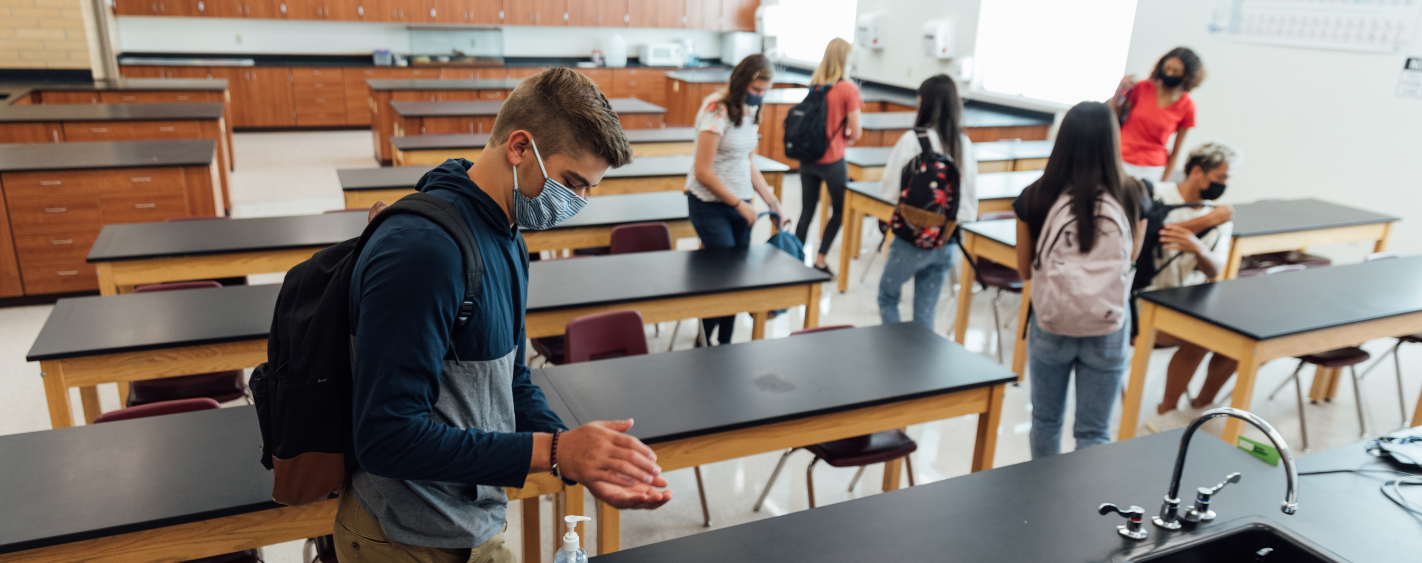
Over the last year, we have learned that COVID-19 infections primarily occur as the result of airborne transmission in indoor spaces. This puts facility managers on the frontlines of the effort to mitigate risks and promote a safe and confident re-entry. This situation is particularly acute and pressing for thousands of K-12 schools across the United States attempting to re-open this Spring.
Public health researchers have determined that strategies such as opening windows, enhancing fresh air delivery, and air filtration can significantly reduce COVID-19 transmission risks. Consequently, IAQ management has emerged as an foundational part of school re-opening plans. However, there are many perspective on these issues, along with new research, recommendations and tools (e.g., Arc Re-Entry).
On February 23, 2021, the Johns Hopkins University Center for Health Security hosted a conversation on indoor air quality and K-12 schools. The session brought together experts from across the United States. The full recording is available on demand, along with reporting from CNN. The following section provides a copy of my remarks.
REMARKS
I appreciate the opportunity to contribute to this distinguished program this afternoon.
Today, we have repeatedly heard the clear and convincing science of indoor transmission and infection control.
I want to talk with you about how we can help facility managers put this science into practice.
Over the last five years, Arc has helped thousands of facilities measure and benchmark human experience and indoor air quality.
Over the past year, we have adapted and extended our tools to support a safe, confident re-entry during and after COVID-19.
Our work is rooted in three foundational beliefs, re-entry requires:
- An iterative management process that can be sustained over days, weeks, and months.
- Occupant engagement. Teachers, students, visitors can be allies in monitoring management practices and providing feedback.
- Measuring real world outcomes. Given irreducible uncertainties, we should measure relevant conditions that we cannot see.
Our approach reflects our confidence that facility management can create safe, comfortable learning environments and our experience that many facilities do not deliver performance consistently.
I want to balance concern about specific mitigation technologies — air changes per minute, HEPA, UVGI, and more — with the reality that any tool must be embedded within an effective, accountable, and transparent management process.
We have created free tools, guidance, and case studies to define and support this process. They are available on our website, www.arcskoru.com, along with examples of their use by schools around the world.
Our approach is rooted in four elements we believe are vital for a safe, confident re-entry:
- Leadership: Empowering specific individuals with responsibility for infection control and providing supportive team members and resources.
- Plans and procedures: Documentation of health-based plans and policies, including clear references to public health authorities — what is being done and what is not.
- Occupant feedback: Surveys that engage faculty, staff, and, potentially, students to provide feedback on practices and performance.
- Real-world monitoring: Timely, relevant, and targeted indoor air quality measurements.
These high-level goals can be translated into trackable performance metrics. In turn, these metrics can be used to:
- Review current conditions
- Evaluate progress over time, and
- Compare practices and performance between facilities and across portfolios.
Our approach is based on our experience that:
- Facility management actions will not always work as intended — in fact, they will fail — often unexpectedly — a significant portion of the time.
- Teachers and students often lack mechanisms to report issues or concerns. Consequently, response to feedback is frequently slow or inadequate. This undermines confidence.
- This occurs against a backdrop of incomplete and fragmented information about management actions, facility operations, and real world conditions. This makes it difficult to target interventions, prioritize action, and evaluate effectiveness.
These are not technology issues. They are fundamentally management and process issues. They must be solved with better management. We believe that we can help by defining better processes and supporting them with practical, accessible tools.
- Every school can establish leadership on infection control and create mechanisms for accountability.
- Every school can be transparent about infection control strategies — including those that they are implementing and those they are not.
- Every school can ask for feedback and engage occupants as partners.
- Every school can find or create opportunities to measure real world performance.
We have appreciated the opportunity to help schools meet this moment. It is worth remembering that we have seen significant, positive developments during the last challenging year, notably including:
- Appreciation for connections between indoor environmental quality and occupant health - we don’t need to convince users that facility management is relevant to health.
- Awareness of the need for more frequent communications and engagement with occupants - facility managers want to know how to communicate with occupants.
- Recognition of the value of measured IAQ data, particularly a shift from annual sampling to continuous measurement - users know they should have more data.
Yet, our stakeholders face challenges:
- The lack of in-house expertise and institutional capabilities — skills, technology, data — in other words, too many random Excel spreadsheets and too few connections to enterprise technology.
- Persistent uncertainty about when and how to communicate with stakeholders - administrators and managers are worried about what they can and should say.
- Concern about costs and technical challenges associated with measuring IAQ - administrators and managers are unsure about what technology to buy, how to use it, how to interpret and apply resulting information.
Overall, this captures where we are right now: tangible progress, significant challenges, and real opportunities to meet the moment in a way that helps address our long-term sustainability goals.
I will close by offering three action items:
- Explore tools, resources, and case studies that any school, anywhere can use today. They are available from the Arc website.
- Consider taking or sharing the Center for Green Schools/ASHRAE survey of IAQ practices, it remains open through the end of the week. A link is available on the Center for Green Schools website.
- Check out the Green Schools Summit for Facilities and Sustainability Leaders, specifically the Healthy Schools and COVID-19 Response on Thursday afternoon (February 25, 2021).
I appreciate your time and consideration. I’m looking forward to the rest of the program.
